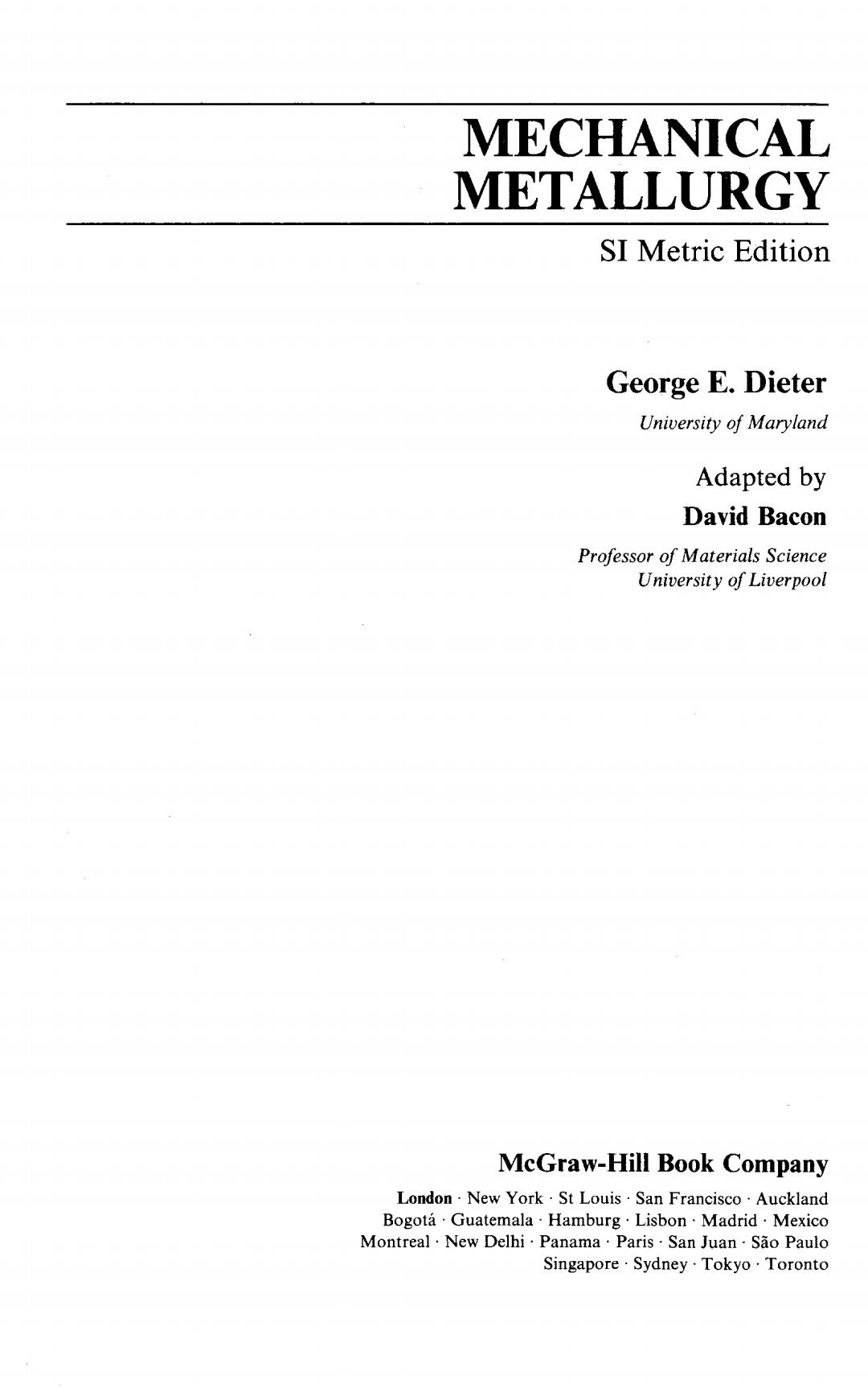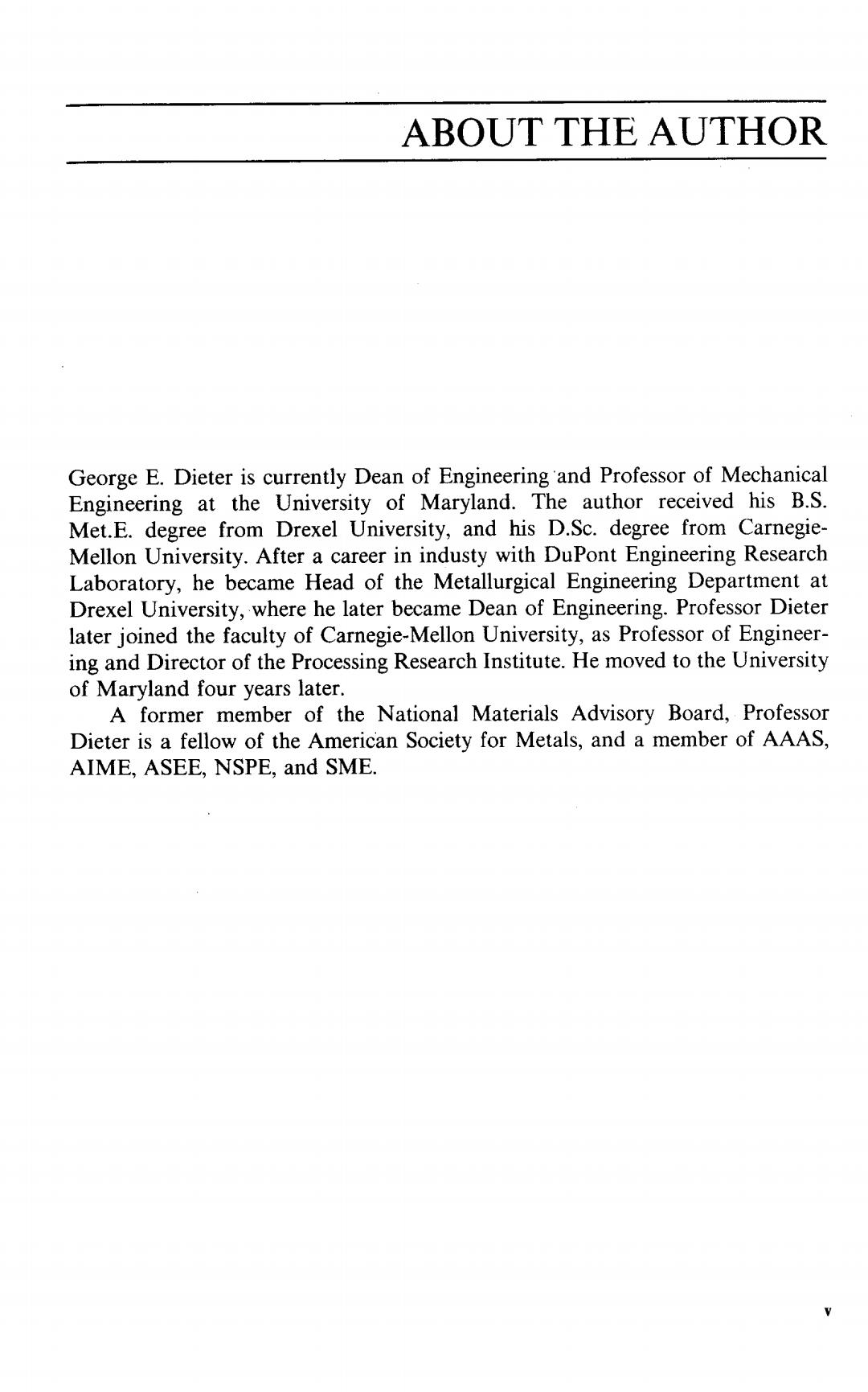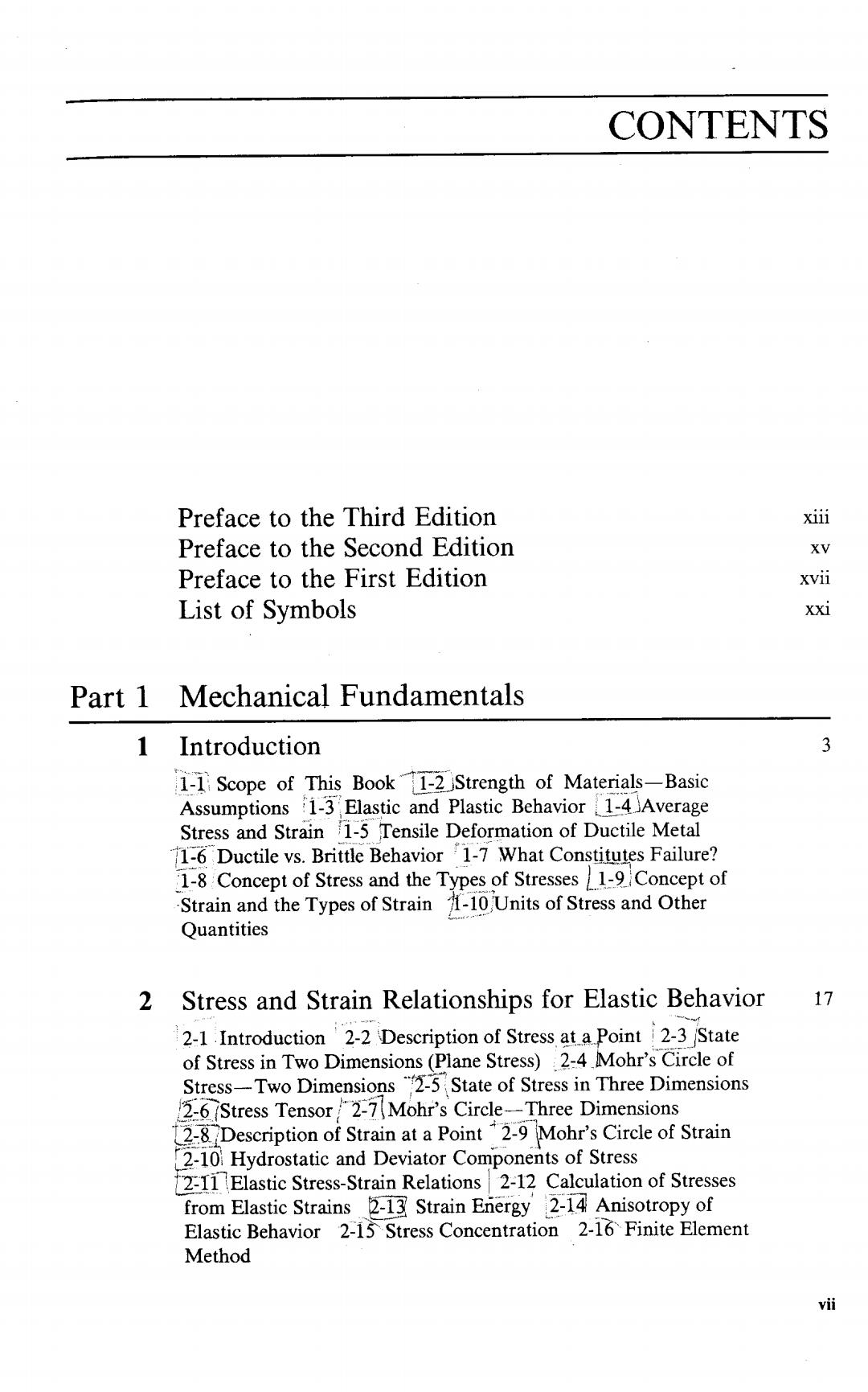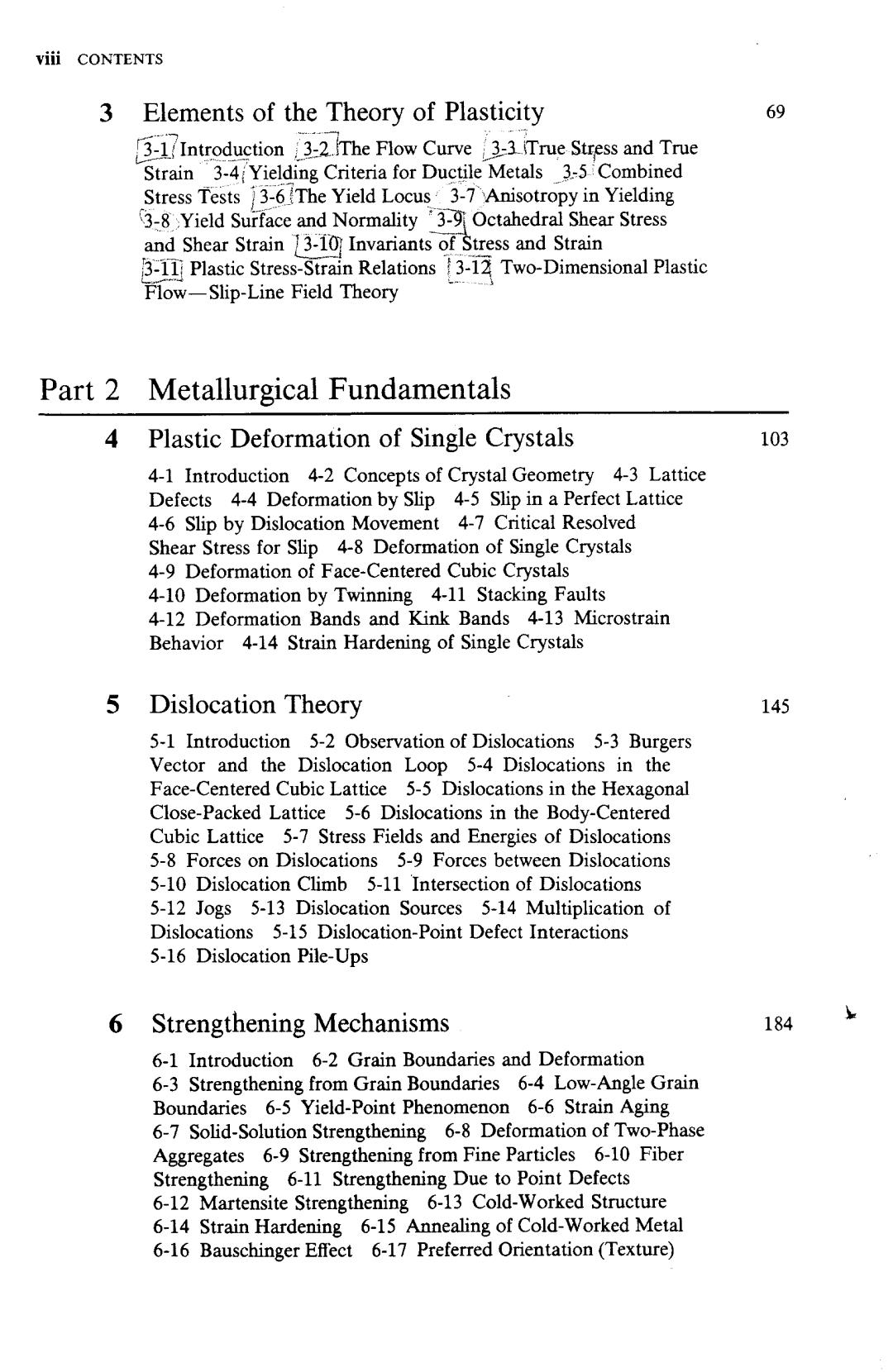
MECHANICAL METALLURGY SI Metric Edition George E.Dieter University of Maryland Adapted by David Bacon Professor of Materials Science University of Liverpool McGraw-Hill Book Company London.New York.St Louis.San Francisco.Auckland Bogota·Guatemala·Hamburg·Lisbon·Madrid·Mexico Montreal·New Delhi,Panama·Paris·San Juan,Sao Paulo Singapore·Sydney·Tokyo·Toronto

ABOUT THE AUTHOR George E.Dieter is currently Dean of Engineering'and Professor of Mechanical Engineering at the University of Maryland.The author received his B.S. Met.E.degree from Drexel University,and his D.Sc.degree from Carnegie- Mellon University.After a career in industy with DuPont Engineering Research Laboratory,he became Head of the Metallurgical Engineering Department at Drexel University,where he later became Dean of Engineering.Professor Dieter later joined the faculty of Carnegie-Mellon University,as Professor of Engineer- ing and Director of the Processing Research Institute.He moved to the University of Maryland four years later. A former member of the National Materials Advisory Board,Professor Dieter is a fellow of the American Society for Metals,and a member of AAAS, AIME,ASEE,NSPE,and SME

CONTENTS Preface to the Third Edition xiii Preface to the Second Edition Xv Preface to the First Edition xvii List of Symbols Xxi Part 1 Mechanical Fundamentals 1 Introduction 3 1-1 Scope of This Book1-2 Strength of Materials-Basic Assumptions 1-3 Elastic and Plastic Behavior 1-4Average Stress and Strain 1-5 Tensile Deformation of Ductile Metal 1-6 Ductile vs.Brittle Behavior 1-7 What Constitutes Failure? 1-8 Concept of Stress and the Types of Stresses1-9Concept of Strain and the Types of Strain -10,Units of Stress and Other Quantities 2 Stress and Strain Relationships for Elastic Behavior 17 2-1 Introduction 2-2 Description of Stress at a Point 2-3 State of Stress in Two Dimensions(Plane Stress)2-4.Mohr's Circle of Stress-Two Dimensions2-5 State of Stress in Three Dimensions 2-67Stress Tensor2-7Mohr's Circle-Three Dimensions 2-8 Description of Strain at a Point2-9 Mohr's Circle of Strain 2-10 Hydrostatic and Deviator Components of Stress 2-11 Elastic Stress-Strain Relations 2-12 Calculation of Stresses from Elastic Strains 2-13 Strain Energy 2-14 Anisotropy of Elastic Behavior 2-15 Stress Concentration 2-16 Finite Element Method vii

viii CONTENTS 3 Elements of the Theory of Plasticity 69 3-1(Introduction 3-2.The Flow Curve3-3True Stress and True Strain 3-4Yielding Criteria for Ductile Metals 3-5 Combined Stress Tests 3-6The Yield Locus 3-7 Anisotropy in Yielding 3-8 Yield Surface and Normality 3-9 Octahedral Shear Stress and Shear Strain 3-10 Invariants of Stress and Strain 3-11 Plastic Stress-Strain Relations 3-12 Two-Dimensional Plastic Flow-Slip-Line Field Theory Part 2 Metallurgical Fundamentals 4 Plastic Deformation of Single Crystals 103 4-1 Introduction 4-2 Concepts of Crystal Geometry 4-3 Lattice Defects 4-4 Deformation by Slip 4-5 Slip in a Perfect Lattice 4-6 Slip by Dislocation Movement 4-7 Critical Resolved Shear Stress for Slip 4-8 Deformation of Single Crystals 4-9 Deformation of Face-Centered Cubic Crystals 4-10 Deformation by Twinning 4-11 Stacking Faults 4-12 Deformation Bands and Kink Bands 4-13 Microstrain Behavior 4-14 Strain Hardening of Single Crystals 5 Dislocation Theory 145 5-1 Introduction 5-2 Observation of Dislocations 5-3 Burgers Vector and the Dislocation Loop 5-4 Dislocations in the Face-Centered Cubic Lattice 5-5 Dislocations in the Hexagonal Close-Packed Lattice 5-6 Dislocations in the Body-Centered Cubic Lattice 5-7 Stress Fields and Energies of Dislocations 5-8 Forces on Dislocations 5-9 Forces between Dislocations 5-10 Dislocation Climb 5-11 Intersection of Dislocations 5-12 Jogs 5-13 Dislocation Sources 5-14 Multiplication of Dislocations 5-15 Dislocation-Point Defect Interactions 5-16 Dislocation Pile-Ups 6 Strengthening Mechanisms 184 6-1 Introduction 6-2 Grain Boundaries and Deformation 6-3 Strengthening from Grain Boundaries 6-4 Low-Angle Grain Boundaries 6-5 Yield-Point Phenomenon 6-6 Strain Aging 6-7 Solid-Solution Strengthening 6-8 Deformation of Two-Phase Aggregates 6-9 Strengthening from Fine Particles 6-10 Fiber Strengthening 6-11 Strengthening Due to Point Defects 6-12 Martensite Strengthening 6-13 Cold-Worked Structure 6-14 Strain Hardening 6-15 Annealing of Cold-Worked Metal 6-16 Bauschinger Effect 6-17 Preferred Orientation (Texture)

CONTENTS IX 7 Fracture 241 7-1 Introduction 7-2 Types of Fracture in Metals 7-3 Theoretical Cohesive Strength of Metals 7-4 Griffith Theory of Brittle Fracture 7-5 Fracture of Single Crystals 7-6 Metallographic Aspects of Fracture 7-7 Fractography 7-8 Dislocation Theories of Brittle Fracture 7-9 Ductile Fracture 7-10 Notch Effects 7-11 Concept of the Fracture Curve 7-12 Fracture under Combined Stresses 7-13 Effect of High Hydrostatic Pressure on Fracture Part 3 applications to Materials Testing 8 The Tension Test 275 8-1 Engineering Stress-Strain Curve 8-2 True-Stress-True-Strain Curve 8-3 Instability in Tension 8-4 Stress Distribution at the Neck 8-5 Ductility Measurement in Tension Test 8-6 Effect of Strain Rate on Flow Properties 8-7 Effect of Temperature on Flow Properties 8-8 Influence of Testing Machine on Flow Properties 8-9 Constitutive Equations 8-10 Further Consideration of Instability 8-11 Stress Relaxation Testing 8-12 Thermally Activated Deformation 8-13 Notch Tensile Test 8-14 Tensile Properties of Steel 8-15 Anisotropy of Tensile Properties 9 The Hardness Test 325 9-1 Introduction 9-2 Brinell Hardness 9-3 Meyer Hardness 9-4 Analysis of Indentation by an Indenter 9-5 Relationship between Hardness and the Flow Curve 9-6 Vickers Hardness 9-7 Rockwell Hardness Test 9-8 Microhardness Tests 9-9 Hardness-Conversion Relationships 9-10 Hardness at Elevated Temperatures 10 The Torsion Test 338 10-1 Introduction 10-2 Mechanical Properties in Torsion 10-3 Torsional Stresses for Large Plastic Strains 10-4 Types of Torsion Failures 10-5 Torsion Test vs.Tension Test 10-6 Hot Torsion Testing 11 Fracture Mechanics 348 11-1 Introduction 11-2 Strain-Energy Release Rate 11-3 Stress Intensity Factor 11-4 Fracture Toughness and Design 11-5 KI Plane-Strain Toughness Testing 11-6 Plasticity Corrections 11-7 Crack Opening Displacement 11-8 J Integral 11-9 R Curve 11-10 Probabilistic Aspects of Fracture Mechanics 11-11 Toughness of Materials